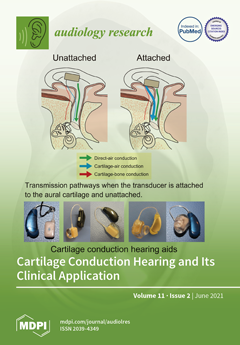Open AccessArticle
Management of Residual Hearing with Cartilage Conduction Hearing Aid after Lateral Temporal Bone Resection: Our Institutional Experience
by
Noritaka Komune, Yoshie Higashino, Kazuha Ishikawa, Tomoko Tabuki, Shogo Masuda, Kensuke Koike, Takahiro Hongo, Kuniaki Sato, Ryutaro Uchi, Masaru Miyazaki, Ryo Shimamoto, Nana Akagi Tsuchihashi, Ryunosuke Kogo, Teppei Noda, Nozomu Matsumoto and Takashi Nakagawa
Cited by 5 | Viewed by 2539
Abstract
Background: There is no guideline for hearing compensation after temporal bone resection. This study aimed to retrospectively analyze surgical cases with reconstruction for hearing preservation after temporal bone malignancy resection and propose a new alternative to compensate for hearing loss. Methods: We retrospectively
[...] Read more.
Background: There is no guideline for hearing compensation after temporal bone resection. This study aimed to retrospectively analyze surgical cases with reconstruction for hearing preservation after temporal bone malignancy resection and propose a new alternative to compensate for hearing loss. Methods: We retrospectively reviewed the medical records of 30 patients who underwent lateral temporal bone surgery for temporal bone malignancy at our institution and examined their hearing abilities after surgery. Result: The hearing outcomes of patients with an external auditory meatus reconstruction varied widely. The mean postoperative air–bone gap at 0.5, 1, 2, and 4 kHz ranged from 22.5 dB to 71.25 dB. On the other hand, the average difference between the aided sound field thresholds with cartilage conduction hearing aid and bone conduction thresholds at 0.5, 1, 2, and 4 kHz ranged from −3.75 to 41.25. More closely located auricular cartilage and temporal bone resulted in smaller differences between the aided sound field and bone conduction thresholds. Conclusions: There is still room for improvement of surgical techniques for reconstruction of the auditory meatus to preserve hearing after temporal bone resection. The cartilage conduction hearing aid may provide non-invasive postoperative hearing compensation after lateral temporal bone resection.
Full article
►▼
Show Figures






